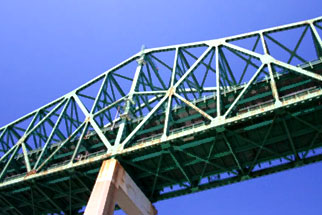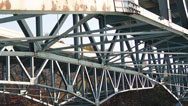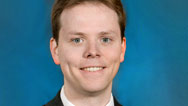Bridge Doctors
- By David Levin
- Posted 07.01.08
- NOVA scienceNOW
In this audio feature, engineer Michael Todd of the University of California at San Diego explains how new sensing technologies may help detect structural problems within bridges before they become dangerous. Underlying many such techniques is something called "active sensing," which enables engineers to effectively listen to the health of a bridge.
 Listen
Listen
In this audio interview, structural engineer Michael Todd describes the state of bridge monitoring around the world.
Transcript
Bridge Doctors
Posted: July 1, 2008
DAVID LEVIN: You're listening to a NOVA scienceNOW podcast. Last year, the Federal Highway Administration labeled more than a quarter of America's 600,000 bridges as structurally deficient or even obsolete. It's a scary fact—one that has people like Michael Todd worried. He's an engineer at the University of California, San Diego and is working on new sensing technologies that can help spot problem areas on bridges before they become dangerous. NOVA's Rima Chaddha spoke with Todd about his pioneering work—a field that's called "structural health monitoring."
RIMA CHADDHA: So what exactly is structural health monitoring?
MICHAEL TODD: Structural health monitoring really could be thought of as the analogy to what you and I do when we want to go see the doctor. You and I get sick, something's wrong, we have a doctor to go to to assess our health and make a prognosis.
Structures don't have that luxury so the field of structural health monitoring has been designed over the last twenty, thirty years to advance technologies that essentially enable us as engineers to get the information we need from our structures and systems so that we can better assess their performance and be able to manage their lifetimes better.
RIMA CHADDHA: So how can you tell if a bridge is "sick"?
MICHAEL TODD: In my research at UC San Diego, we are working on wireless-powered sensors that can be deployed out on structures such as bridges that do not require resident power, 'cause last time I checked many bridges don't come with automatic plug-ins for power.
A technology that we've been working on that we hope we'll be able to implement into this wireless mode very soon is this concept of "active sensing," and "active sensing" is a term we take from the sonar community, really, where people use devices to essentially beam out acoustic energy, sound energy, and they essentially look at the reflections of that energy from various objects. That's how submarines detect each other and other things. What we do is launch waves with these active sensors into the structure.
RIMA CHADDHA: How can sound waves tell you if something's broken, though?
MICHAEL TODD: They go out and they interact with the structures as they move along, and they may or may not encounter things like damage, cracks, conditions that are abnormal.
So we "ping" the bridge, and we listen to its response, and effectively we determine whether the bridge's "song," if you will, is a happy song or one that needs a little further investigation.
RIMA CHADDHA: So where are those kinds of bridges being built?
MICHAEL TODD: The Hong Kong local Chinese government and the Hong Kong transportation department have effectively instrumented three large-scale bridges, and when I say instrumented, I mean thousands of channels of different kinds of data. They have a central command center where all the bridge data comes back to this hub, and this data is all mined and processed there to do a number of different things, even down to minute-by-minute management of traffic on the bridge, when to open and close certain lanes for optimal flow, when to close and open certain lanes due to typhoons that come through the Hong Kong region.
RIMA CHADDHA: But why aren't we using that technology here in the U.S.?
MICHAEL TODD: Well the technologies are really there. It's a matter of getting the systems optimized, built and deployed in the applications where the economics warrant it. In America we simply don't have the investment by the government and state agencies to be able to properly manage our bridges.
But in Korea, after a famous bridge collapse during rush hour in Seoul in 1994, I believe, the Korean government mandated that future construction would have to have monitoring technology of some kind on it. They have decided that the investment of government and other resources into infrastructure was just a simply higher priority than perhaps it's been in America.
RIMA CHADDHA: After last year's bridge collapse in Minneapolis, do you think the American government would start using those technologies on a wider scale?
MICHAEL TODD: I think that we, like most communities, are also reaction-driven, and the Minneapolis collapse certainly caused the same kind of critical look at ourselves as a community and how we invest our money in scientific development, in my opinion. So, I am very hopeful that American investment will continue in this area, and I know that the U.S. Congress in the wake of the Minneapolis bridge collapse took a very strong, serious look at this as well.
Credits
Audio
- Produced by
- Rima Chaddha and David Levin
- Interview by
- Rima Chaddha
Image
- (bridge)
- © NOVA/WGBH Educational Foundation
Related Links
-

Smart Bridges
Can we engineer bridges that tell us what's wrong with them before it's too late?
-

Smart Bridges: Expert Q&A
The University of Michigan's Jerome Lynch answers questions about the future for "smart" bridges, and more.
-

Why the Bridges Failed
Find out what caused eight infamous bridge collapses.
You need the Flash Player plug-in to view this content.



